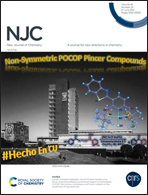A naked-eye colorimetric sensor based on chalcone for the sequential recognition of copper(ii) and sulfide ions in semi-aqueous solution: spectroscopic and theoretical approaches†
Abstract
In this study, a simple colorimetric chemosensor based on the chalcone scaffold has been employed for the sequential recognition of Cu2+ and S2− ions in a semi-aqueous solution. The chemosensor A01 displayed chromogenic selectivity for Cu2+ over other metal cations and exhibited naked-eye color change from colorless to pink upon the addition of Cu2+. Furthermore, the A01–Cu2+ complex can be used for the detection of S2− ions through competitive complexation of S2− toward Cu2+. The detection limit of the chemosensor A01 for Cu2+ and A01–Cu2+ complex for S2− ions is 1.3 μM and 0.4 μM, respectively, which is quite below the acceptable detection limit suggested by the WHO guidelines for drinking water. The chemosensor A01 binds reversibly to Cu2+, and the UV-vis changes induced by Cu2+ could be reverted via treatment with EDTA. To further enhance the applicability of the colorimetric chemosensor A01, the Cu2+ ions concentration was measured in real environmental water samples.



 Please wait while we load your content...
Please wait while we load your content...